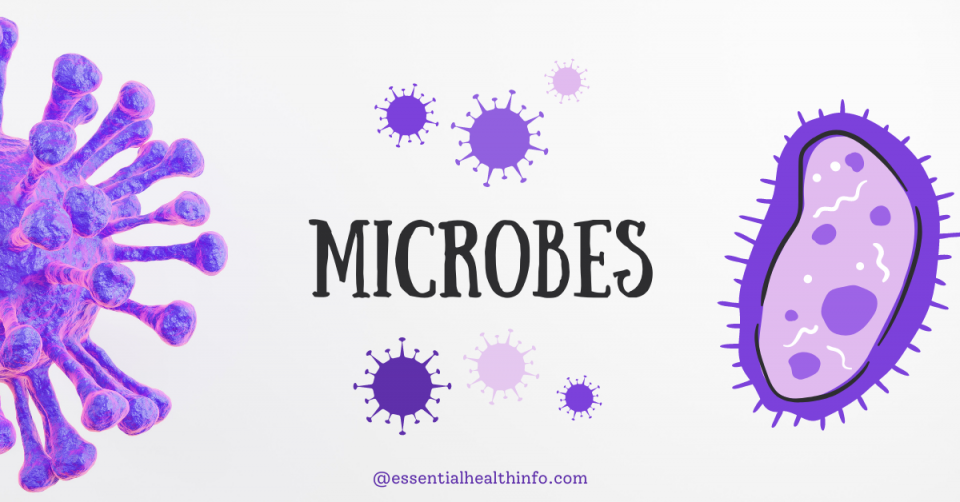Ask yourself this question, “What is an infection?” Before you begin skimming through this article, take a second to think about the term infection. If you believe an infection is a disease, then you may be surprised to hear that it is not! Infection is the entry, establishment, and multiplication of pathogenic organisms within a host (Professor et al., 2021). First, let’s survey the types of organisms that can become pathogenic. A microorganism is a tiny living thing only visible under certain magnification and are bacteria, fungi, and viruses. Viruses are acellular (without a cell membrane) microorganisms. Helminths are not a microorganism but are visible and is the term that defines all parasites. Altogether, these are the types of microbes that can cause an infectious disease– bacteria, fungi, protozoa, helminths, and viruses.
Similarly, we are all familiar with the term “virus” since our world has spent the last two years fighting against SARS. However, infections are not only caused by viruses. As mentioned earlier, a microorganism is a tiny microbe that provides benefits to humans and the earth, but they can become a pathogen. Before we dive into how an infection causes a disease, let’s look at the role microbes play inside the human host and on this earth.
Microbes, the “Good Guys”
“Microbes are deeply involved in the flow of energy and food through the earth’s ecosystems (pp. 7).” When it comes to biological processes like photosynthesis, microorganisms like bacteria (and algae) account for greater than 70% that contributes to the majority of oxygen in the atmosphere (pp. 7). Not convinced yet? Let’s talk some more about these interesting facts on these so called, “germs” and how they help our environment.
Many of the gases produced on this earth such as methane, carbon dioxide, and nitrous oxide create an insulation layer in the atmosphere and helps retain heat (pp. 7). Have you any idea what produces these gases? Other than decomposing animals, microbes create these gases. Other than God, microorganisms are the main creators that make the earth abundant for all organisms. Did you know, for example, that 2 Liters of ocean water contains 1 billion bacteria (pp. 7)? As mentioned before, bacteria are the main contributors to photosynthesis, but their close cousin’s “virus” are the other most abundant, although acellular, microbe that plays a major role in photosynthesis and helps sustain the earth.
Finally, did you know that bacteria live inside the intestines for humans and animals like cows? Microbes form a symbiotic relationship with its host and can digest complex carbohydrates in animals that cause them to produce methane into the atmosphere (pp. 7). Microbes are flexible in their versatility, which makes them great components for symbiosis, an intimate association between individuals from two species.
Normal Biota (Resident Microbes)
As we dive deeper into describing microbes, the microbiome is the entire sum of all microbes found on or in a human. Yes, you read that right! On your very skin are microscopic microbes that have been acquired by many surfaces and other humans. Inside, there are a variety of environmental niches, with wide variations in temperature, pH, nutrients, and oxygen tension occurring from one area to another where the body provides a range of habitats (pp. 313). These places on and inside the human body harbor the normal biota:
- skin
- upper respiratory tract
- gastrointestinal tract
- external genitalia
- vagina
- external ear canal
- external eye (lids, conjunctiva)
- bladder
- breast (and breast milk)
Also, the intestinal biota can affect a person’s health. For example, scientists have found correlations between the gut microbiome and heart disease, asthma, and even mood (pp. 313). Not to mention, we have microbes in places like the lungs, although there are very little. But, did you know that invading microbe must contact our normal biota first (as a part of their purpose to establish themselves) (pp. 313)? Normal biota exist in a safe and steady relationship with the host and will protect the host from incoming pathogenic microbes. To be precise, there are several microbes that would cause disease if there were more of them (on and inside our body) like Staphylococcus aureus. However, when we acquire microbes that lead to colonization, our body is in danger of infection and even disease. Let’s look at how an infection leads to disease.
Infections that Lead to Disease
It’s important to understand that a human can be immunocompromised or likely to contract a disease because of their body’s current state. As stated earlier, we have normal biota on our body as well as inside. Furthermore, these are the processes that weaken the host defenses (our natural defenses to ward off infection) and can increase our susceptibility to infection (pp. 314):
- older age and infancy
- genetic defects
- surgery (organ transplants)
- underlying disease like diabetes
- chemotherapy
- physical and mental stress
- pregnancy
- other infections
Did you know that our body has more microbial cells than our human cells (pp. 312)? For the most part, our resident microbiota will colonize in and on our bodies long term and not cause disease (pp. 312). Remember, colonization is the formation of microbes (bacteria, virus, parasites, or helminths) that if pathogenic can infect us and cause disease. If our normal biota encounters these microbes through specific portals of entry, then they can eventually lead to colonization. On the other side of the coin, these invading microbes can be similar species to our normal biota such as Staphylococcus aureus. So let’s define the terms- infection and disease.
Infection is a condition in the body when a colony of microbes has successfully moved past our defenses, entered the tissues, and multiplied (colonized). Either of these two will occur- our body will respond to the microbe colonization through signs like a fever or the microbe colonization will go undetected. Disease is the pathologic state as the colonized microbes disrupts tissues and organs causing damage (pp. 312). Finally, once the body is in the state of disease, the toxicity caused by an infectious agent is called an infectious disease.
Portals of Entry
As we develop the infectious disease complex, let’s now take a final look at what happens when the infectious agent moves past the host defenses. First, different portals of entry have a protective process that prevents these microbes from gaining entry. Can you think of one defense mechanism that protects us? If you said skin, then you are correct! For example, did you know that the eyes secrete tears to rinse probable pathogenic microbes? These are the types of microbes that can get past certain portals of entry (pp. 313)-
Skin (& an example of disease)
- Staphylococcus aureus “staph infection”
- Streptococcus pyogenes “pharyngitis”
- Helminths worms (parasite) “toxoplasmosis”
- Viruses “malaria”
How Access is Gained
- abrasions, punctures in skin, areas of broken skin
- mouth entry, mucous membranes of lips
- burrow through the skin
- insect bites
Gastrointestinal Tract & How Access is Gained
Salmonella, E.Coli., hepatitis A, Shigella (through eating & drinking contaminated foods, fluids, touching infected inanimate objects)
Respiratory Tract & How Access is Gained
Streptococcus pneumonia, Mycobacterium, tuberculosis, Bacteria causing meningitis, influenza “the flu“, measles, mumps, chicken pox, rubella, common cold (inhaling the pathogenic microbe from the air and touching respiratory droplets on inanimate objects)
Summary
Whether the invading microbes cause disease, the human body is garnished with host defenses. Most microbes are in the middle when it comes to invading the body, which means they only cause disease under circumstances. On the other hand, if there is a low defense system in the host because they are immunocompromised, the resident microbes can act differently. Opportunistic pathogens are either resident microbes or invading microbes that take advantage of its host (pp. 313). This can also be a result from a polymicrobial infection, which is a multiple of species that get past the host defenses such as an infection influenza that becomes pneumonia. Influenza is caused by a virus but can lead to pneumonia under the right circumstances because a virus can infect a bacterium, now called a bacteriophage (pp. 313). Not to mention, several skin infections are caused by Staphylococcus aureus and Streptococcus both. When these two species are cultivated together, they can create Moraxella, which is a polymicrobial infection. On the other hand, each invading microbe has a severity called a virulence factor that determines its pathogenic effects in a host.
To summarize, a microbe can only cause an infectious disease depending on these criteria:
- establishing itself in a host (getting past the defense barriers)
- cause damage (based on the virulence factor or the pathogenic severity and/or the host’s immune system that determines the level of defense)
References
Professor, C. M. K., Smith, H., & Lusk, J. (2021). ISE Microbiology Fundamentals: A Clinical Approach (ISE HED MICROBIOLOGY). In Microbiology Fundamentals: A Clinical Approach (4th ed., pp. 410–411). McGraw-Hill Education. https://myebooks.mheducation.com/bookshelf/ebooks


